
Quality lighting is one of the MANY factors that go into making a photograph a masterpiece, and Profoto’s mission is to ensure that photographers get the best of it. Their goal is to deliver excellence in photography lighting equipment and make a photographer’s life easier and this goal is what put them at the top of our list for our latest Vendor Spotlight interview.
Profoto is the go-to gold standard for light shaping tools that help pro photographers enhance their lighting game. When we asked Mark Rezzonico, President of Profoto North America, “What makes Profoto stand out as a company?” he told us, “It’s the reliability and the quality assurance. It’s also knowing that you’re investing in a system that’s going to be with you for your whole career.” Reliability, quality, consistency – YES! But as we explored Profoto, we also noticed that they not only want to offer the best product but also the best service to photographers. Why should photographers consider investing in Profoto? Read on to find out more about the company, how it supports the photographer beyond its products, and what the future of lighting looks like for wedding and portrait photographers.
Profoto was founded in the ’60s when two friends had had enough of the mediocre quality of on and off camera light available at the time. With a desire to produce a quality lighting product for photographers, the duo started Profoto – a company committed to research and development, to learning what photographers want and need, and to building products that make photographer’s lives easier. “We’re really about making products designed for the needs of photographers. Even if the photographers don’t realize what the need is,” Mark shared.
And if you are still on the fence about joining the Profoto family, here are a few reasons why making that investment could be a great move for your photography business.
Why Profoto?
- Lighting products built specifically for photographer’s needs.
- Easy to set up and simple to use tech.
- They are big on reliability.
- At their core, Profoto is all about innovation, with every new product being better than the previous one.
- They offer over 150 light shaping tools to choose from.
ShootDotEdit: Let’s start with the origin story. Tell us a little bit about how you got started in Profoto and how the company started.
Mark: The company started in the ’60s with two friends, Conny (Dufgran) and Eckhard (Heine), and they were very passionate about what they did. One was a salesman, and one was an engineer, and neither was really happy with what flashes were available at the time. And Eckhard famously said, “I’m going to build the best flash system in the world.” And Connie said, “If you build the best flash system in the world, I’m going to sell it.” And that was the start of the company.
Originally, the focus of the company was designing the very best lighting products for the professional fashion market. It was one product that was designed to give the fastest flash duration and the shortest recycling time available. So if somebody was shooting models and moving, they could keep up with the action. That’s the foundation of where the company got started, and we will always have loyalty from the fashion photographer because that’s where we started. Later on, of course, we recognized that there were many other worlds of professional photography outside of the fashion world. And we started working a lot with self-contained lights, doing work with portrait photographers. We had separate power packs that were designed for tabletop commercial photographers. And in 2013, we started working on portability with a battery-operated light for on-location wedding and portrait photographers.
A couple of years ago, we came out with our own portable on-camera studio light called the A1. The A1 series of products is now in the third generation of R&D. It’s a light that fits on the hot shoe of your camera, but it gives you all the advantages of a studio flash and the same quality of light as a studio flash. And that’s really what the company has always wanted to do – to look at each segment, come out with products specific to that market segment, specific to those customers’ needs, and then develop the very best product for the customer.
Personally, I got into photography very young. I was probably 13 or 14-years-old when I remember being at the grocery store with my mother and seeing the magazines on the checkout rack and saying, “That’s what I would like to do. I’d like to photograph those people.” It’s always been a passion of mine. I started working, I went to college for photography, and I started working in a retail store while I was in school. And, then I went to work for Hasselblad for a few years. I was with broncolor for 10 years, and I’ve been with Profoto for about the last 23 years.
Suggested Read: The Best Decision You Could Ever Make For Your Photography Business

ShootDotEdit: That’s a long stint with a company. You must really love it!
Mark: I absolutely adore the company, and I adore the people, and I like the whole philosophy of what we’re all about. We’re really about making products designed for the needs of photographers. Even if the photographers don’t realize what the need is. And that’s one of my favorite stories about where the B1 and the TTL movement really came from. We had a product called the D1, and we started doing some focus groups of what the next generation should be. And unlike most companies, we don’t ask what features we should have in a product. We asked, “What do you like about what you’re doing?” and “What don’t you like about what you’re doing?” We asked Profoto customers, and we asked non-Profoto customers in an anonymous, mail-in survey first. And then we took all the interesting answers, and we got them together in person. We had 10 groups of 10 people over three cities, and we dug deeper into their workflow and what their needs were.
Nobody asked for TTL (Through The Lens metering). Not once did TTL ever come up! But at the end of it, it was very obvious that there were a few challenges that the wedding and portrait photographers had. And this was probably in or around 2008. And the problem that most wedding and portrait photographers had was not a lack of skill or a lack of ability. It was a difference in the way you focus. So when a portrait photographer steps into a shoot, they’re focusing on the client, they’re focusing on the expression, they’re focusing on that moment, capturing that solitary moment.
When you talk to a commercial photographer where somebody is doing food photography, they’re focusing on the lighting being exactly perfect. They’ve got time to adjust everything and make it exactly right. That’s the mentality of a commercial photographer versus a people photographer. When you talk to a people photographer it’s not about precision. They tell us, “It’s okay if the exposure is not perfect, and it’s okay if the lighting isn’t exactly right, because it’s the expression, it’s the moment, that matters – that’s what we really need to capture. If we have the right expression, we’ll sell the picture every single time. If we have great lighting and a bad expression, we’re never going to sell it.” And that kind of got us thinking that maybe we should be focusing on making the technology easier. Instead of it being more feature-rich and more labor-intensive, we should go the opposite way. How do we get the photographer to take the picture with the least resistance and using the easiest path possible? So nobody said TTL, but it was very obvious that we needed to do something in the lighting world that was going to make a photographer’s life genuinely easier.
ShootDotEdit: That is such a great way to put it. Photographers don’t ALWAYS know what they want, so having the instinct to work on products that photographers don’t even know that they need – or know they need but don’t know how to ask for – is amazing. Because they don’t necessarily always have a term for what they want but they do know that they want X.
Mark: One of the other challenges that photographers have is they don’t know what everybody else in the business is developing. Most photographers don’t know what the next generation of camera is. And when you look at product development, that can take anywhere from 6 months to 2-3 years for development. So I don’t want to know what you need today. I want to understand what you’re doing today, and I want to understand how that interfaces with the products that I know are coming out tomorrow from other companies. What are the camera companies going to have in their cameras? Or what is the next capture device? Where are cell phones going to be in 2-3 years in terms of a shoot, and how do we integrate that into what we’re doing? So we’re planning our product development in parallel to the other products.
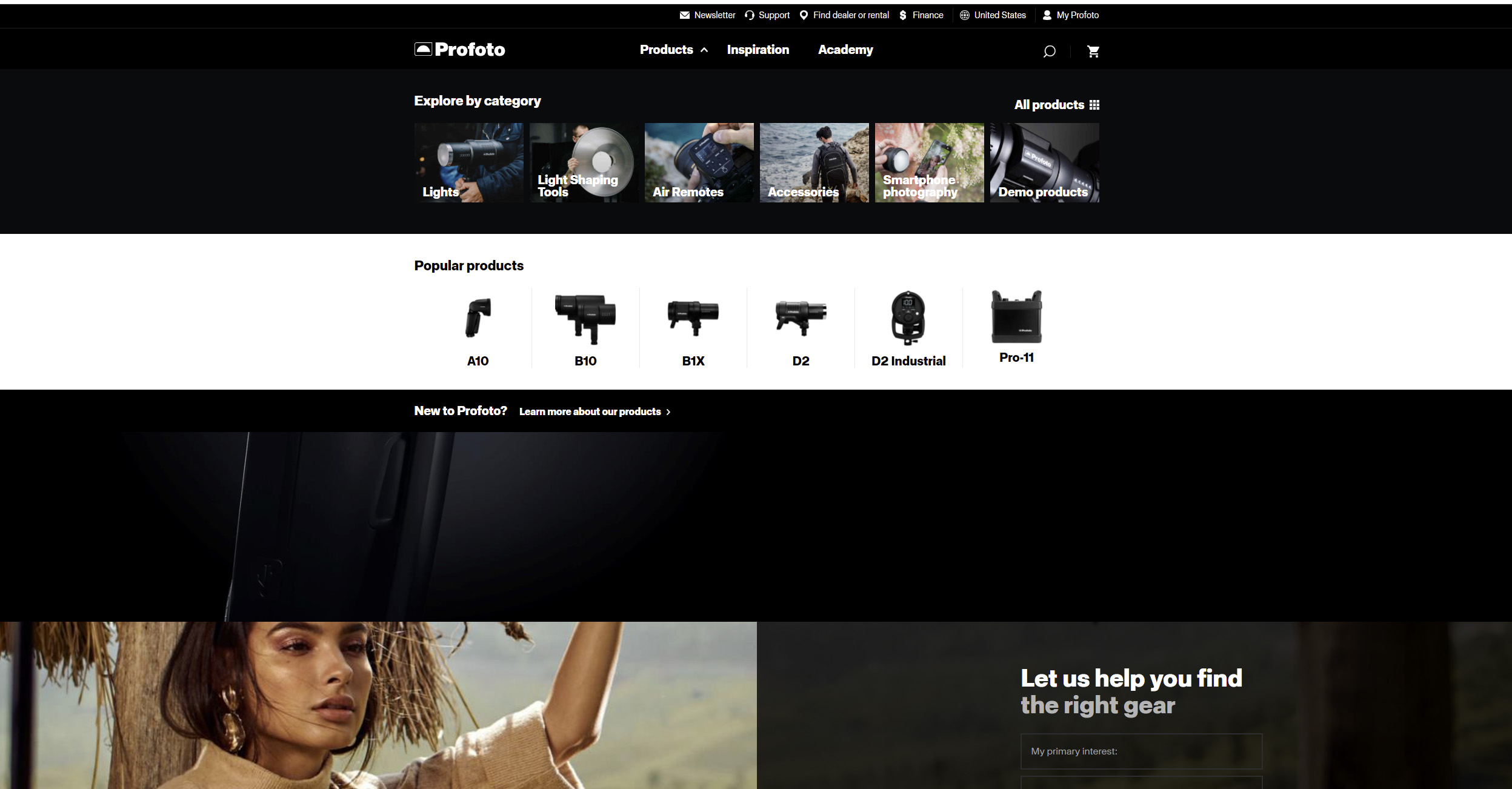
ShootDotEdit: Which brings us to our next question. How do you project for the future? How do you look 4 years ahead, or 3 years ahead, or however fast the technology is changing and say, “This is what we need to start on now, so that we can be not just on par, but ahead of the game 4 years from now.”
Mark: We have professional relationships with a lot of other companies in Japan and with the camera companies in that and other countries. So if we know what the camera companies are doing, and they know what we’re doing, and we’re developing products with a synergy, that certainly helps. It’s not always that, and that’s not always easy. Sometimes, it’s really about paying attention to what the technology is and where the technology is going.
A few years ago, if you said that photographers were going to start taking pictures with cell phones and Apple was going to become probably the biggest camera manufacturer in the world, you’d say that’s the craziest thing you’ve ever heard. A major food magazine did a whole issue taken with a cell phone. And this was 3 or 4 years ago. And when asked why they did that, they said, “Because our customers are looking at food at restaurants, and they’re taking pictures with their phones in restaurants. And that’s the perspective and angle and what they’re expecting to see being represented in the magazine.” Now, everyone has seen billboards taken with an iPhone. And almost every phone company, if you see their commercials on TV, they have nothing to do with making a phone call or even sending email anymore. Now, it’s all about how good the camera is.
ShootDotEdit: That’s absolutely true! And technology is just way too smart now. How does that make you feel? Because you started in food photography, right?
Mark: That was my beginning, yeah. I actually embrace it. I mean, frankly, it’s a terrible thing as a creative to fear technology because technology can be your friend. It shouldn’t dictate how you drive your career, but you should always be looking to incorporate the latest technologies and stay on the cutting edge because cameras have gotten so much smarter.
When I started, we were using 4×5 and 8×10 view cameras. And today, there are probably very, very few photographers that are still using view cameras, and it breaks my heart because that’s where my passion lies. But today, a DSLR or a mirrorless camera has really fantastic image quality. And the power that we have in programs like Photoshop gives us a lot of control.
Is it better? Is it easier? It almost doesn’t matter because it’s the technology that we use. I know many companies that have gone out of business because they fought the technological changes instead of embracing them. And they wanted to hold onto their old technology because that’s where their profit was. And they drove their business into the ground because they didn’t embrace it. They became obsolete, and it was a choice they made. And that drives me nuts because the business is evolving. Our lives are evolving. Everything we do in every part of our life is evolving. If embracing technology can make my life better, if it can make my job easier, if it can give me better results, more consistent results, more reliable results than I was getting before, why not use it?
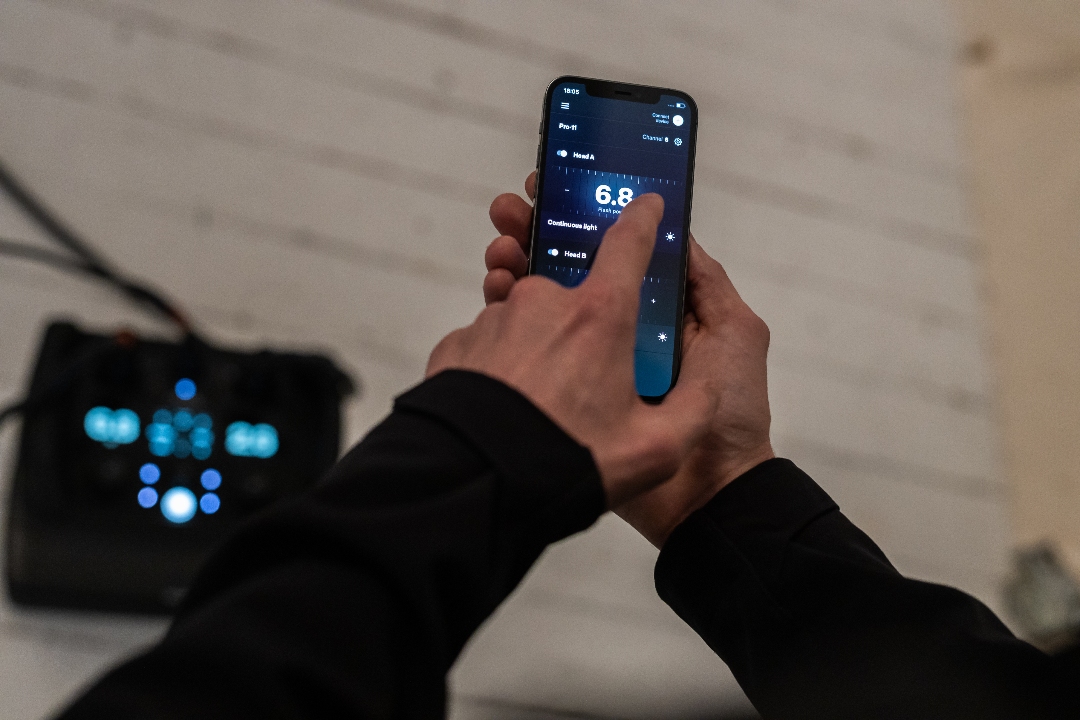
Using a phone for photography is absolutely where people are at right now – whether you are at a beach or an amusement park, everybody’s just taking pictures with their phones. Even a lot of the behind-the-scenes stuff in the fashion world is being done with cell phones. But it’s still not the norm for professional photo shoots. But because people are definitely trending that way, we want to keep up. So a few years ago we came out with the C1 and the C1 Plus, which were lights designed specifically around taking pictures with your phone. And then earlier this year, we introduced Air X technology, which is really an integration of a Bluetooth module in the light that talks to your phone and not only lets you take pictures with your phone, but also lets you control when the light flashes with your phone.
ShootDotEdit: We love that Profoto is embracing technology and evolving to make things faster and easier for the photographer!
Mark: Right! It doesn’t really matter what camera platform you use, and it doesn’t matter what camera technology you use. You’re always going to want to create the best image possible, regardless of what you’re doing. And to really create a high-end repeatable professional look, you have to use lighting. You don’t always have the luxury of being in a place that has perfect lighting, and you’re not always going to just walk in and use available light to take a great photo. So you need to be prepared. A true photographer is someone who is in control of the elements and is able to reproduce that look and that feel over and over again without having to wait for the sun to be in the right place. You’re working around the client’s schedule, not the client working around the solar schedule and to me, that’s the most important thing. So regardless of what you’re doing, regardless of what you’re shooting, regardless of what you’re using to shoot it, regardless of when you want to shoot it, it’s always going to be about the lighting. We’re always going to need to be able to reproduce that quality of light in a repeatable, easy way. And so no matter what you do, you’re always going to need flash. And that’s why Profoto is around.
ShootDotEdit: We agree! That’s the mark of a pro. Someone who can create the best image with the best light even in less-than-ideal conditions. It’s about light. Always and everywhere.
Mark: If you show up at a wedding and it happens to be a bright and sunny day or a terribly overcast day, or it’s raining, you can’t tell the bride and groom, “Let’s just go shoot this on another day. Let’s forget about your special day.” You have to be able to adapt. And you can’t say, “Sorry, your pictures didn’t come out as good as you wanted them because it rained that day, or it was too sunny that day.” So it’s really about being in control of the environment and creating something that everybody is really proud of and that the customer ultimately really loves and wants to pay for. And then they’ll recommend you to all their friends and that leads to more jobs. So that’s what Profoto helps with. The equipment only goes so far. Good lighting doesn’t make you a great photographer any more than a good camera makes you a great photographer, any more than a good set of golf clubs makes you a great golfer, but having the right tools to do what you want to do certainly will get you from A to B much faster.
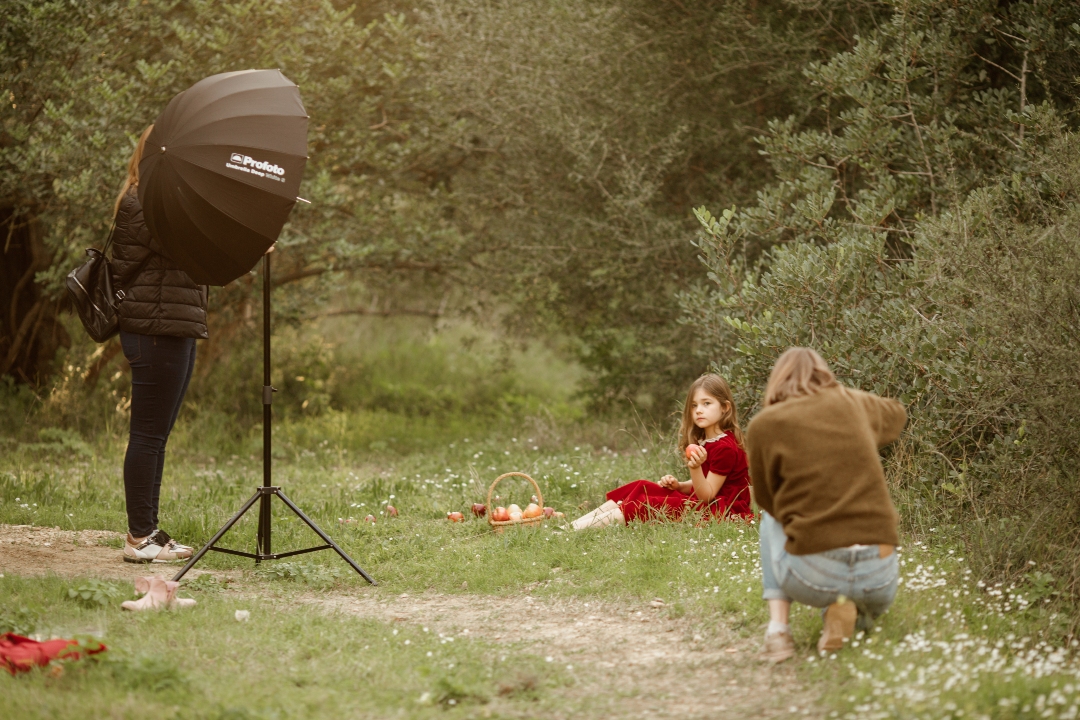
ShootDotEdit: What would you tell people who are afraid of off-camera lighting?
Mark: I would say jump in, the water’s fine. When I was in school, we were using 8×10 Large Format Film cameras and it was $6 for a piece of film. And then you had to pay to process it. The reason for not experimenting enough was that it was a financially draining experience. But with today’s digital cameras or your cell phone, you can sit around and take pictures all day long and it’s free. You can experiment. You can have a loved one sitting on a chair, a friend sitting on a chair, your next-door neighbor sitting on a chair. You could tell the kid next door, the one who’s graduating, that you’ll do some free graduation pictures and you’re going to play with some lighting. Play with it, have fun with it. Don’t be afraid of it, embrace it.
The thing that separates one photographer from the other is not what camera they use, but their lighting style. Nobody looks at Ansel Adams’ work and says, “Oh my God, these are really great. And they’re only great because he used a View Camera .” They look at it because he set his camera up, and he would wait for days sometimes until the lighting was perfect and only then make the image. The lighting really is what photography is all about. So I would say don’t be limited by your fear. Just embrace it and try something. It’s free. Take all the pictures you want. Move the light close, move it farther away, try a different reflector, bounce it off something, use a softbox, use a hard reflector. See if you can look at a picture in a magazine and recreate that lighting, because if you can do that, you can really understand what lighting is and what it’s all about.
Suggested Read: Top 5 Tips For Utilizing Off-Camera Lighting
ShootDotEdit: Okay, so picture this: We are brand new to lighting and don’t know a thing about lighting except how to use natural light. What is the one product from Profoto that you would suggest we as a photographer start with?
Mark: So first I would ask you what you want to do. Because one thing that makes Profoto special is we have products that appeal to every type of photography. So we have small lights specifically made for portability. We have a family of lighting products for people who are shooting portraits and weddings. We have lighting for the fashion and commercial world. So it’s hard to say what the one right product is without knowing what you’re doing. If you say, “I’m going to do some wedding pictures, and I want to be light and portable.” I would suggest the A10 because it is an on-camera light. It can also be used off-camera. It’s got a built-in remote that does all the functions of our sophisticated remotes, but it’s built into the unit. So later on, even if you expand and add a B10 to your setup, you can use the A10 as the remote for your other flashes, which is really a handy feature. And it’s great because it’s very easy. It’s very versatile. It can be on camera, can be off-camera, it’s small, it’s light, and it’s really an inexpensive point of entry into the Profoto family.
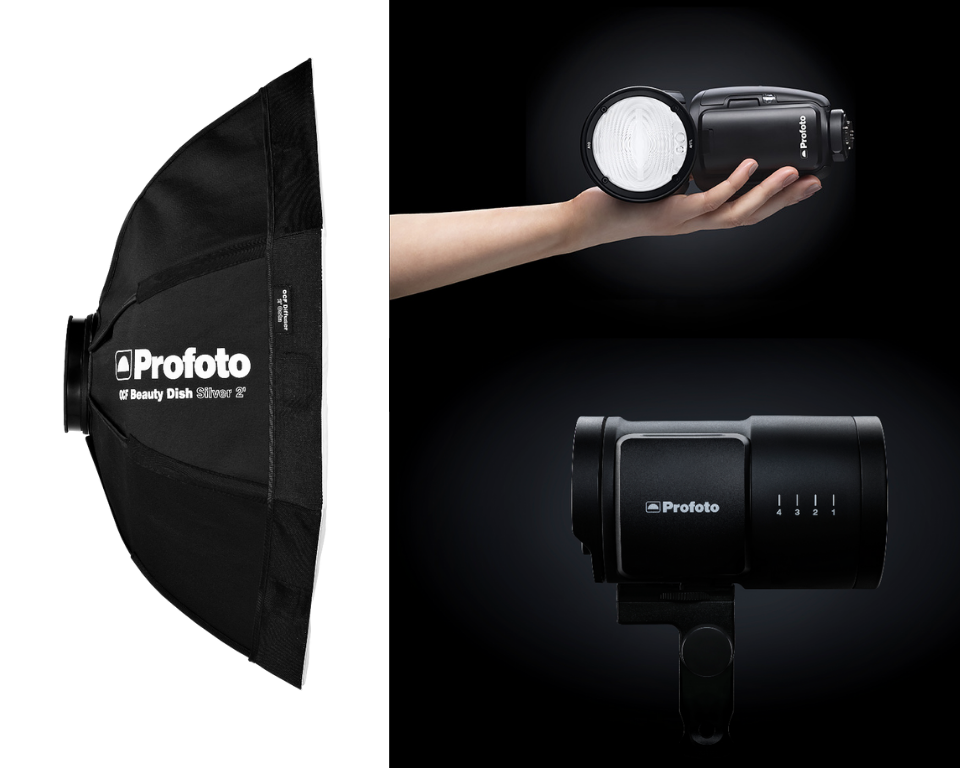
ShootDotEdit: How about for a reception set up? Say for a wedding photographer at an indoor venue or even an outdoor venue – what does the ideal Profoto setup look like? And ideal, of course, can be different for every photographer. But what is the go-to?
Mark: I think the B10 today has really become the standard. The B10 and B10 Plus are unique because they’re really small and portable. They’re about the size of a lens, so you could stick them in a camera bag or on a light stand or on a boom arm or a monopod. You can clamp them anywhere you want. And they’re really easy to use and very powerful. And they are part of the Profoto system so you can use all our light shapers regardless of what lights you choose. You can use your softbox or your beauty dish or all these other things that are really unique to Profoto. And you can put them on all your Profoto lights. So as your career changes, as you grow your repertoire of lights, you’re still using the same shapers and still getting that same quality of light.
ShootDotEdit: So, why Profoto as compared to any other off-camera lighting? Why should that be a photographer’s choice? Because it’s a higher price point than many of the other options.
Mark: For me, the why is very simple. It works. You don’t need a college degree to use it. It’s easy. It’s intuitive. You turn it on. It works. I don’t need to know what’s happening. I don’t need to know what all the settings are. I don’t need to be dealing with all the science and the technology. And there’s a huge amount of technology in it, but I don’t have to think about it. I turn the light on, I push the button, and it flashes, and it works every time. It’s the same color temperature, and the same output. And the quality of light is exactly what I’m used to and what I want. So there are no surprises.
If I was shooting hundreds of pictures at a wedding reception, the last thing I’d want to do is get back to my studio and go into retouching and start working on every single image individually because the light was a little off or the color was a little off or the exposure was different. It’s much better to get it right in camera. And that’s really what Profoto gives you. It gives you that consistency right off the bat.
Once you get past the price and start thinking about investing in the system, it’s a different mindset. The cost savings comes because you don’t have to go through 3 or 4 or 5 different brands of strobe before you get what you’re really looking for. With Profoto, you’re investing in a system, and the system is going to work your entire career, no matter what you do in photography. There’s always going to be a part of this system that’s going to work for you.
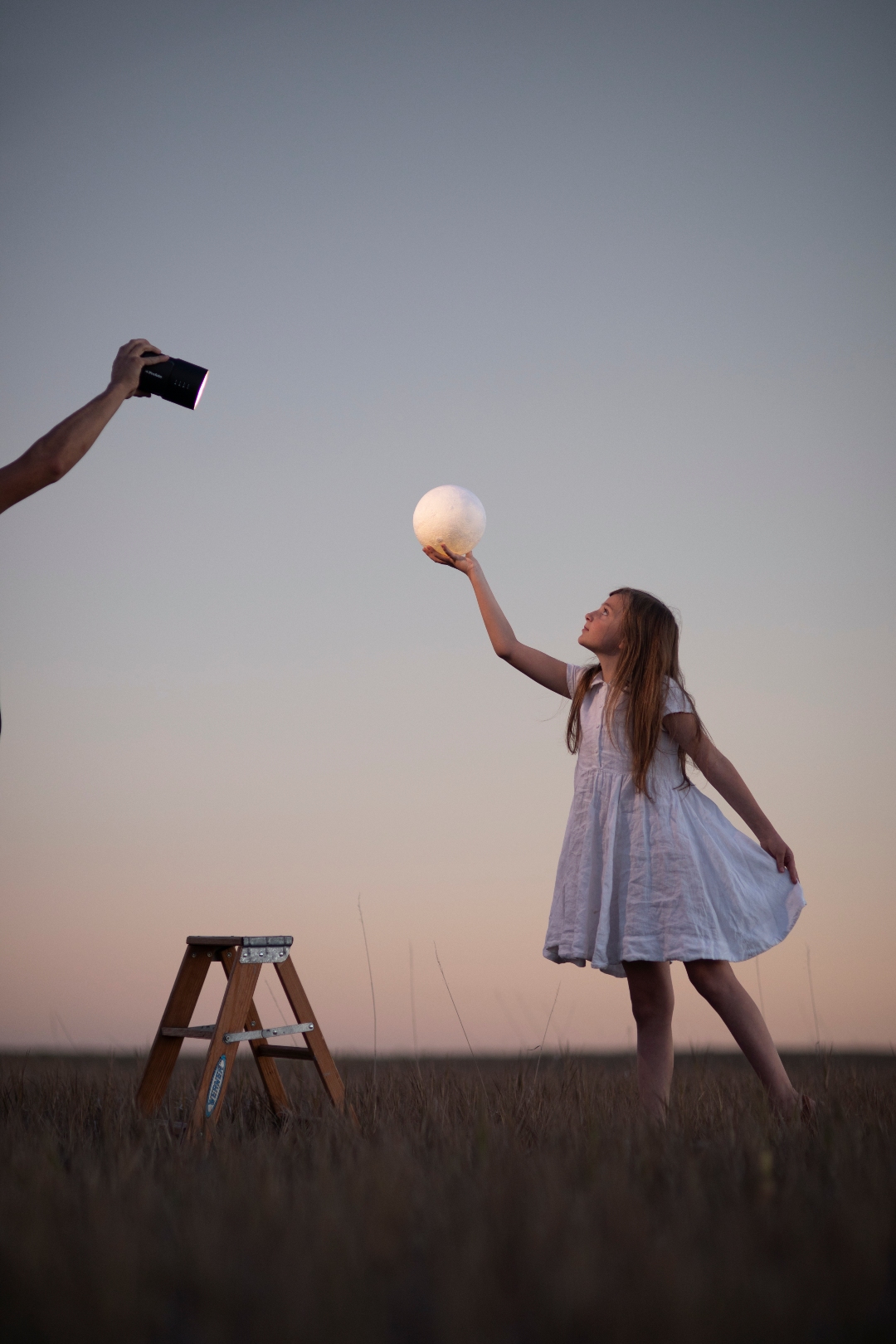
ShootDotEdit: What is the future of Profoto? What are you excited about?
Mark: I could tell you, but then I’d have to kill you. : ) We have always invested more in research and development than any other company, and that’s how we’re able to offer the breadth of products that we do. So at any given moment, there are 5-10 products on the horizon. We’ll have additional things coming on a regular basis for years to come.
ShootDotEdit: Since you do work with so many other companies and people, tell us, are there vendors that you work super closely with or any Profoto users you highlight and want us to know about?
Mark: It’s hard to play favorites. I couldn’t, in good faith, mention one company or one photographer because we deal with so many different companies and people. If you’re in the fashion world, and you look at people like Annie Leibovitz or Albert Watson or Patrick Demarchelier, you know the flavor of who we are and who we serve and the same thing holds true in the other worlds. If you go to our website, you can see our Legends of Light – the top leading photographers in the wedding and portrait world that use Profoto. And we try to support everybody. We are not about favoritism. We’re just really trying to support the market and develop and supply products that help photographers achieve their goals better. Our motto is really just ensuring quality, ensuring the best light in every image. And that’s really what we want to do. If you have a vision, we want to help you make it easy to get that vision.
ShootDotEdit: Even though you’ve touched on it in different ways earlier, can you summarize your ‘why’ for us?
Mark: The ‘why’ behind Profoto is the reliability, it’s the quality assurance, it’s knowing that you’re investing in a system that’s going to be with you for your whole career. Profoto lights are tools in your toolkit that are going to do what you want them to do and work as you expect them to work. They are not going to hinder how you want to shoot, but they’re going to enhance how you shoot and make your life easier. You also are investing in a company that’s going to support the products. We’re the US subsidiary. We don’t do any product innovation here. We’re not doing any R&D here. We’re the sales and marketing hub, and one of the most important things that we offer is service to and for photographers who use our lights. So when the photographer has a problem with a product (because let’s face it, everything needs maintenance, everything needs service), we have that covered nationwide. We have a network of repair centers, so we can make sure you can get the very best service as fast as you can. If you have technical questions about a product we offer, we have live people that you can call in and speak to. We also have online resources to use, and we have educational resources, and we have video resources on YouTube. So we’re not only trying to sell a box, but we’re trying to educate photographers how to use the box. And we’re trying to make sure that we’re supporting that customer with the box after the purchase.

ShootDotEdit: What is something that people don’t know about Profoto that you’d want them to know about, or a feature that you’re so blown away by that nobody uses, but they should.
Mark: For me, it always comes back to the light shaping tools. Too often, we get focused on a conversation about watt-seconds. We get focused on the f-stop that you’re going to get. For me, it’s really about the quality of light. It’s when you put a light on a skin tone and see how smooth it is, and see the gradations from highlight to shadow, and have this extensive group of light shaping tools available that really let you control all that. That, for me, regardless of whether it’s Profoto or not, is probably the most exciting thing about flash. Light shaping and the quality of light are really what’s creating the image. So we just happen to have the biggest supply of accessories and light shaping tools around, which is just expanding the opportunity for photographers.
ShootDotEdit: So what’s a great shaping tool that is sort of a catch-all, go-to for any outdoor portrait?
Mark: My all-time favorite is the beauty dish. We have a hard beauty dish, and we have some collapsible versions, some softbox-type versions. And because the light comes out and hits a counter-reflector and gets bounced back in, there’s a real indirect quality to it, but because of the size and because of the shape, it’s still a very directional light. So you’re getting more lighting characteristics. You’re getting a little more shadow. But it’s still got those transitions of a soft light. And that’s really one of the things that makes it unique.
The flip side of that is I love a reflector we call the Magnum reflector, and you can think of it as sunshine in the late afternoon where you have just a beam of light coming out. It’s a more direct light, it’s a harder shadow but it’s not a harsh light. It’s a soft light to mimic the sun. And I think that really makes it a super versatile light. After that, softboxes and umbrellas are a staple of any photographer’s lighting package.
ShootDotEdit: And besides your products, is there anything else that you want to highlight about your services?
Mark: We just started a relationship with a company called SweetPay. We can’t lower our price because we’re not in control of the cost and the manufacturing and so on. But one of the things we can do is we can lower the price of entry with financing. We’ve always had some sort of financing over the years, and usually, it’s focused around the commercial customer, larger orders with proof of corporation and your tax documents, and everything else that you’d have to provide. And SweetPay is the first company that we’ve used to offer financing to all photographers. It’s a super simple process that doesn’t have any of the hoops to jump through. The customer just goes to our website and clicks on the financing tab. They can select where they want to buy from our list of dealers participating in the program. And there’s a very simple, less than five-minute application that you fill out, and you instantly get your decision. And if you’re approved, then you get offers from multiple leasing companies for different amounts, over different amounts of time, with different interest rates, depending on the company that’s offering them to you.
And when you click yes, you get an e-doc that you sign almost immediately, and the money is transferred into your account the next day. So it takes away all the intermediary steps of having the dealer and a leasing rep involved. And it’s a way a customer can afford Profoto lights with one click on the website to apply and get funded right away.
ShootDotEdit: So, from a visionary perspective, what do you think the future of lighting is in the wedding and pro photography space?
Mark: I think the needs of the wedding photographer are for a light that is smaller and lighter. Portability is a huge thing, something that is faster to set up is a huge thing. I think you’ll see smaller lights and more portable accessories, things that are designed to go up and down much quicker. Continuous light is great, and I love continuous light, and you’ll probably see more of that being incorporated, but there are still challenges with continuous light because it’s on all the time. People are going to be squinting. You’re never really going to have the amount of power in a short period of time as you would with flash to freeze action. So there’s always going to be an advantage to using strobes. So I think strobes are going to be around for a while. You’ll probably see less power needs as ISOs go up. But you’re still going to have the need for flash. I’ll be retired, and flash will still be around.
ShootDotEdit: Do you ever personally go to any of the trade shows like WPPI?
Mark: Sure. I mean, one of the things that I think is so important for photographers today is education and learning. We are where we are because we make a point to learn the trends in the business, the trends among other manufacturers, and knowing what the needs of the photographer are going to be down the road. And I think photographers need to do the same – to go out and meet the manufacturers, to understand what their philosophies are, where their products are going. You’re not really buying a product for today – you really want to be investing in a product for the future too. And it’s also great to hear from other photographers – what techniques they’re doing, what works for them, what doesn’t. I go to trade shows because I want to hear what photographers are thinking, what photographers are saying. That’s huge when it comes to the input and feedback we give the factory on the products that we want to see.
Suggested Read: Upcoming Photography Workshops & Conferences: 2021 & 2022
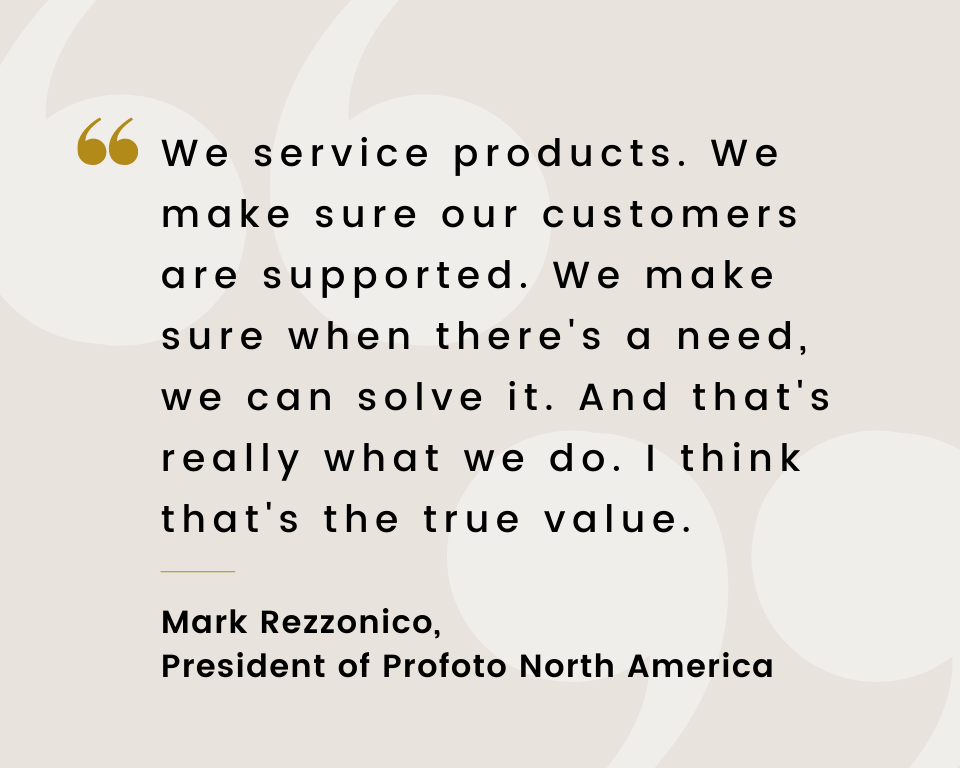
ShootDotEdit: So tell us in summary, what is the one thing you want photographers, whether they’re your followers or ours, to know about Profoto.
Mark: The real reason to go with Profoto is you’re dealing with more than just the product. You’re dealing with the very best product, with the best technology, the best components. You’re dealing with a product that has the best line of accessories and the tools that will let you shape light for the rest of your career and stay with one brand. And you’re also dealing with a company that stands behind the product. We’re servicing products. We’re making sure our customers are supported. We’re making sure when there’s a need, we can solve it. And that’s really what we do. And I think that’s the true value. If you have the best light in the world and there’s nobody there to fix it or when a problem occurs, and there’s no one to answer a question about how that product integrates with a camera or they don’t have the accessories that you need to create the image, that light doesn’t really do you much good.
It’s really not one component. It’s the whole package that really makes a difference. Nobody would think Canon or Nikon or Fuji or Sony was a great camera if they also didn’t have lenses and the accessories to go with it. And it’s easy when you look at cameras to look at the system. But for some reason, when you look at lighting, there’s a disconnect. It becomes about watt-seconds or power or f-stop, and everything else is secondary.
Further Read: Rangefinder Is Not Just A Resource For Photographers, It’s A Community Too: Jacqueline Tobin, Editor-in-Chief
Our Vendor Spotlight series has led us to some extremely committed and genuinely caring entrepreneurs who truly want to make a photographer’s life easier through innovation and technology. By the end of our conversation with Mark, we yet again found ourselves speaking to someone who was also on a journey to find new ways to serve the photographer. Profoto’s products and customers speak for the company. Their efforts to keep improving, especially by listening to what it is that photographers want and incorporating that into their products, not only aligns with our own process at ShootDotEdit, but also perfectly fits our criteria for who we choose for these interviews.
Mark, thank you for taking the time to take us through the ins and outs of Profoto. We hope that you continue to lead with your visionary perspective and keep going strong with your mission to make a photographer’s life easier with your reliable and innovative products. You can find Profoto on Instagram, Facebook, LinkedIn, Twitter, and their website.
At ShootDotEdit, we also strive to make your life easier and more enjoyable by giving you the time to focus on doing things that you love. So, if editing is taking up too much of your time, we can free up some of that by doing it for you. To learn more about our professional editing services and how they help your wedding photography business, check out our pricing plans.


Leave a comment